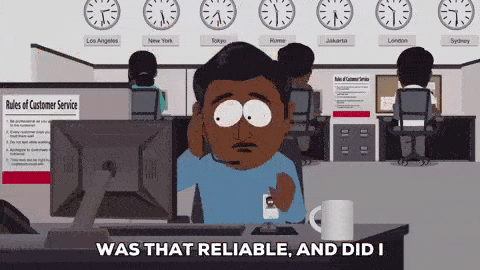Hoe Intercom een eenhoornproduct werd
Iconische producten aflevering 002
Sinds de oprichting in de favoriete koffietent van de oprichters, is Intercom ongelooflijk snel gegroeid.

Groeiend van $1 miljoen naar $50 miljoen aan jaarlijks terugkerende inkomsten in slechts 3 jaar (tussen 2014 en 2017), is het misschien wel een van de snelst groeiende tech startups die er zijn. Het groeit sneller dan Shopify, Twilio, Zendesk, HubSpot... en wordt alleen overtroffen door Slack. 📈
Deze groei kan grotendeels worden toegeschreven aan mond-tot-mondreclame, die op zijn beurt wordt veroorzaakt door een iconisch product.
Is het product zo geweldig? Waarom? Hoe?
Laten we erin duiken. 👇
Intercom brengt menselijke relaties naar het internet
Waarschijnlijk net als een aanzienlijk aantal startups, begon Intercom met een paar hipster nerds die rondhingen in een koffietent in Dublin, genaamd Third Floor Espresso. ☕

Ze zaten daar te kijken naar de interactie van de eigenaar met klanten, het ontwikkelen van echte menselijke relaties en het opbouwen van klantentrouw. En dan stelden ze dat tegenover de klantenrelaties die ze hadden bij hun eigen tech startup in die tijd, Exceptional.
Ze deden hun hele bedrijf via internet. Ontmoetten hun klanten nauwelijks. Bouwden geen menselijke relaties op. En daardoor geen echte loyaliteit. 🙁
En hoewel er heel wat softwaresystemen beschikbaar waren om met klanten te communiceren, stonden ze het opbouwen van deze relaties vaker in de weg.

Probeer een echte band op te bouwen als je tickets voor klantenondersteuning uitdeelt of generieke e-mailcampagnes verstuurt via onhandige producten die veel handelingen vereisen om iets gedaan te krijgen. 😒
Ze wilden het praat-naar-actuele-mensen-probleem van het internet oplossen. Om menselijkheid terug te brengen in de internetbusiness. Vanuit de overtuiging dat relaties bedrijven beter maken.
Intercom is gebouwd voor specifieke "klussen die moeten worden geklaard".
Een van de belangrijkste inzichten van de oprichters van Intercom was dat producten het opbouwen van relaties uit de weg moeten gaan.
Producten worden ingehuurd om een specifieke klus te klaren. En ze moeten zo efficiënt en gericht mogelijk op dit doel worden gebouwd.
Veel bedrijven richten hun denken op klantpersona's. Het Intercom team zegt: persona's zijn cool, maar ze vertellen niet het hele verhaal. Ze zijn voor empathie, niet voor fris productdenken. 💭
Waar de jongens van Trello het hebben over het negeren van individuele feature requests zelf, en in plaats daarvan focussen op de pijnpunten in de workflow (meer daarover in de vorige aflevering over Trello), brengt het Intercom team het "Jobs To Be Done" framework in.
Ze richten zich op waarom mensen functies willen. In welke situatie, met welke motivatie, met welk doel.
Mensen zijn experts in hun probleem, niet in de oplossing. Het Intercom team zoomt in op de oplossing in al haar aspecten.

Voor elke functie maken ze een "job story": 👇
Wanneer _____, Ik wil _____, Dus ik kan _____
Deze werkverhalen worden dan van begin tot eind uitgewerkt, van de eerste gedachte tot tevredenheid. Het hele verhaal zo efficiënt en doelgericht mogelijk.
Ontbundeling van het Intercom-product brengt focus
In het begin was Intercom één grote monolithische oplossing.
Het team wilde één geïntegreerde oplossing die een helpdesk, e-mailing, live chat, marketingautomatisering en een klantendatabase omvat. Omspant de hele klantrelatie.
Het probleem was dat veel klanten Intercom alleen wilden inhuren voor één klus, misschien twee klussen, maar niet voor de hele shebang.
Ze raakten ook in de war over wat Intercom was: is het een helpdesk? Is het een chat? Is het een e-mailplatform? 🤔

Het opsplitsen van Intercom in afzonderlijke - maar geïntegreerde - producten maakte een veel strakkere probleemoplossing mogelijk, zonder de visie van het faciliteren van de hele klantrelatie los te laten.
Het maakte alles veel gerichter: het product, de onboarding, de berichtgeving, de advertenties. 😌
Verschillende wegen werden gecreëerd naar Intercom. En in de andere richting werden verschillende wegen gecreëerd voor Intercom naar hun klanten.
Intercom heeft in de loop der tijd veel gegoocheld met deze producten. Pas sinds het Salesflare team is begonnen met Intercom, zijn producten samengevoegd, hernoemd en verschillende keren verplaatst.
De productnaamgeving was historisch heel duidelijk over de precieze taak die elk product zou uitvoeren, met namen als Acquire, Engage, Respond, en Educate. De recente naamgeving Berichten, Artikelen, en Inbox neemt hier afstand van en ruilt duidelijkheid over de uit te voeren taak in voor pure eenvoud.
Intercom blijft zijn kern opnieuw uitvinden
In tegenstelling tot veel andere producten, blijft Intercom zich bewust richten op de kernfunctionaliteit. Niet op het toevoegen van leuke nieuwe foefjes, maar op het beter maken van het product. 🔧
Het team gelooft dat het meer waard is om te werken aan het verbeteren van de kernfunctionaliteit, dan om te werken aan randfunctionaliteit, of zelfs om nieuwe functionaliteit toe te voegen.
Zij geloven dat je grootsheid bereikt in 1000 kleine stapjes en dat je vooruitgang boekt door honderden kleine releases die waarde toevoegen aan klanten.

Om een geweldig en gebruiksvriendelijk product te maken, moet je alle onnodige complexiteit wegnemen, zodat elke gebruiker zijn problemen zo efficiënt mogelijk kan oplossen. Het gaat erom te kijken naar het kleinst mogelijke deel van de workflow waar je product waarde levert en dat te verbeteren.
Maar het gaat ook om het opnieuw uitvinden van complete ervaringen. Het team heroverweegt vaak hoe het product is ingedeeld, hoe het onboarden van klanten werkt.
Een van de bekendste veranderingen die Intercom in zijn geschiedenis heeft doorgevoerd, is het mogelijk maken om het product te gebruiken zonder de code op je website te installeren.
Ze bedachten dat als hun platform ook kon worden gebruikt als een emailmarketingplatform, waarom dan geen parallelle onboarding maken waarvoor je alleen een .csv-bestand met klantgegevens hoeft te importeren. Importeer, filter en verstuur e-mails.
Conversie gepiekt door 40%. 😲

Toch is dit een van die legendarische succesmomenten waar iedereen van droomt. De realiteit is dat, ook voor Intercom, het grootste deel van het succes komt door de cumulatie van kleine verbeteringen.
Intercom is vastbesloten om relevant te blijven
Tijdens mijn recente koffie met Intercom mede-oprichter Des Traynor (binnenkort op Founder Coffee), vertelde Des dat hij zichzelf over 10-20 jaar nog steeds bij Intercom ziet werken.
Het Intercom team bouwt aan hun bedrijf, product en merk voor de lange termijn. Zonder te weten wat de toekomst zal brengen, zijn ze vastbesloten om relevant te blijven. 💪
Intercom werkt aan het verbeteren van de klantenbinding voor internetbedrijven met een gecentraliseerd platform waarin messaging centraal staat, en ik denk dat we het daar allemaal wel over eens zijn:
- Klantenloyaliteit en menselijke relaties zijn tijdloos
- Het internet is een blijvertje en het aantal internetbedrijven zal alleen maar toenemen
- Mensen blijven genieten van alles op één plek
- Berichten vervangen e-mail (hoewel dat waarschijnlijk meer iets tijdelijks is)
En zelfs als de communicatiemedia sneller veranderen, zullen de "Jobs To Be Done" nog veel langer blijven bestaan.
Intercom zal zijn strategie niet volledig veranderen vanwege smartwatches, spraakopdrachten, machine learning, gamification of big data. Het zal misschien gebruik maken van deze technologieën, maar het zal zijn bedrijf niet opbouwen rond een hype.
Het team vergelijkt hun product graag met faxapparaten. Faxapparaten waren heel nuttig in een heel specifieke periode. Nu zijn ze verdwenen. ☠

Zakelijke communicatie tussen mensen is een blijvertje... en we hopen van harte dat dat betekent dat Intercom ook een blijvertje is.
Ga zo door, team Intercom! 🤘
Laatst bijgewerkt:
- 7 Beste CRM's voor Mac in 2025 - 19 september 2025
- 7 Beste HubSpot CRM Alternatieven in 2025 - 17 september 2025
- 7 Beste alternatieven voor Pipedrive in 2025 - 16 september 2025
